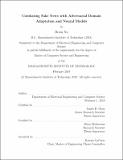Combating fake news with adversarial domain adaptation and neural models
Author(s)
Xu, Brian(Brian W.)
Download1102057862-MIT.pdf (970.9Kb)
Other Contributors
Massachusetts Institute of Technology. Department of Electrical Engineering and Computer Science.
Advisor
James R. Glass and Mitra Mohtarami.
Terms of use
Metadata
Show full item recordAbstract
Factually incorrect claims on the web and in social media can cause considerable damage to individuals and societies by misleading them. As we enter an era where it is easier than ever to disseminate "fake news" and other dubious claims, automatic fact checking becomes an essential tool to help people discern fact from fiction. In this thesis, we focus on two main tasks: fact checking which involves classifying an input claim with respect to its veracity, and stance detection which involves determining the perspective of a document with respect to a claim. For the fact checking task, we present Bidirectional Long Short Term Memory (Bi-LSTM) and Convolutional Neural Network (CNN) based models and conduct our experiments on the LIAR dataset [Wang, 2017], a recently released fact checking task. Our model outperforms the state of the art baseline on this dataset. For the stance detection task, we present bag of words (BOW) and CNN based models in hierarchy schemes. These architectures are then supplemented with an adversarial domain adaptation technique, which helps the models overcome dataset size limitations. We test the performance of these models by using the Fake News Challenge (FNC) [Pomerleau and Rao, 2017], the Fact Extraction and VERification (FEVER) [Thorne et al., 2018], and the Stanford Natural Language Inference (SNLI) [Bowman et al., 2015] datasets. Our experiments yielded a model which has state of the art performance on FNC target data by using FEVER source data coupled with adversarial domain adaptation [Xu et al., 2018].
Description
This electronic version was submitted by the student author. The certified thesis is available in the Institute Archives and Special Collections. Thesis: M. Eng., Massachusetts Institute of Technology, Department of Electrical Engineering and Computer Science, 2019 Cataloged from student-submitted PDF version of thesis. Includes bibliographical references (pages 77-80).
Date issued
2019Department
Massachusetts Institute of Technology. Department of Electrical Engineering and Computer SciencePublisher
Massachusetts Institute of Technology
Keywords
Electrical Engineering and Computer Science.